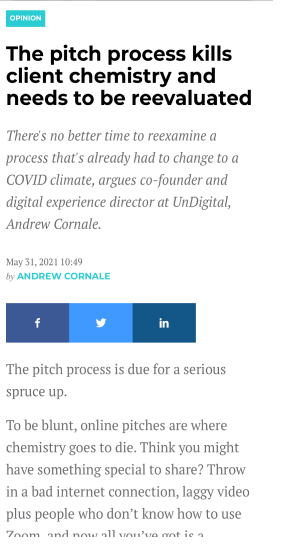There's no better time to reexamine a process that's already had to change to a COVID climate, argues co-founder and digital experience director at UnDigital, Andrew Cornale.
The pitch process is due for a serious spruce up.
To be blunt, online pitches are where chemistry goes to die. Think you might have something special to share? Throw in a bad internet connection, laggy video plus people who don’t know how to use Zoom, and now all you’ve got is a disjointed meeting filled with disinterested people. Agencies might genuinely have something special and exciting to share with the client, but the standard pitch process is just draining and ineffective. From the long-winded briefs that are somehow still vague to the 100 page PDF you send off without much hope, the process simply strips good ideas of what makes them so great. This process really needs to be reevaluated.
Exciting ideas deserve to be delivered in exciting ways
The biggest issue with the pitch process is its relentlessly boring nature. All too often, briefs are given in long-winded documents and a ‘solution’ to the client’s problem has already been outlined. For the agency at the other end, the pitch response becomes a document whereby they’re just proving they’re capable of ticking certain boxes. It completely lacks creativity and leaves no room for the agency to recommend a different, and perhaps better, solution.
With this as the case, agencies are restricted in how they can express creativity and generate excitement for a project. They become a number in a system to be judged explicitly on how well they can articulate their skills on paper. It holds no regard for the value of a good client/agency relationship, respect and general chemistry. The idea that any sound judgement can be made from a piece of paper is outdated, naive and set up to fail. Digital projects are a puzzle and they require collaboration for all the pieces to fit together. Online submissions are one-sided and lacking in any collaborative nature.
Building relationships over Zoom
The virtual pitching room is torture for everyone involved. It’s like all the elements for success are there yet something fundamental is missing.
Great idea that you’re ready to present – tick
Skilled team to provide support – tick
Client prepped and ready to hear the pitch – tick
Ability to read the room and pivot accordingly – hard no.
It might not be in the marking criteria, but the ability to build rapport with clients and have personalities that complement each other is the unwritten rule for success. Without this, it’s like dating without going on a date. There is almost no opportunity for the expression of personality or creativity and this makes it difficult to evaluate whether or not you’re a good fit for each other.
The pandemic may have made face-to-face meetings difficult for a while there, but as Australia gets back to normal, I’d strongly urge agency employees to meet up for a COVID-safe coffee with their prospective clients. It truly can make or break a deal for you.
Working with an outdated process
Outdated processes can make you want to throw in the towel, but it’s important to stay focused and evaluate the best way to work with the client. Just because someone is currently working with an outdated process, doesn’t mean they’re not open to other options. Oftentimes, your client will inherit processes from those before them and lack the time to devise a new solution. Taking the time to come to them with something actionable may just make it across the line. For the agency, it’s an excellent way to show the client that you care about their business beyond the scope. For the client, they get a solution that is better suited to their problem and allows them to reach their goal more efficiently. It’s a win-win for everyone involved.
The standard pitch process can be tedious, especially when it feels like good, innovative ideas are getting lost in paperwork. At times like this it can be tempting to throw in the towel, but agencies should stand by the process they believe sees to the best outcome for both themselves and the client. While this can be an unnerving conversation, going the extra mile and putting in this effort can often result in invaluable and long-term client relationships.



